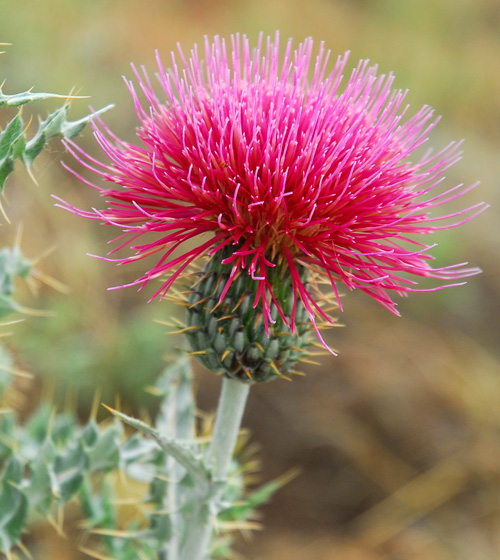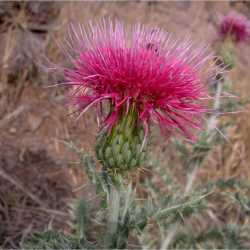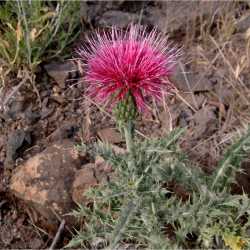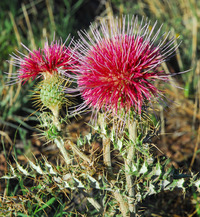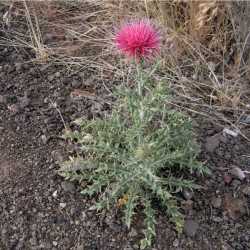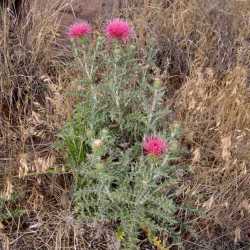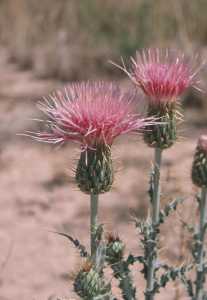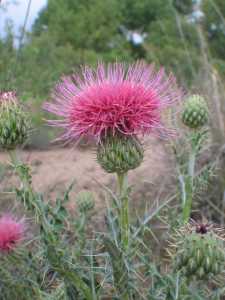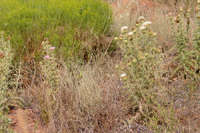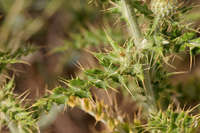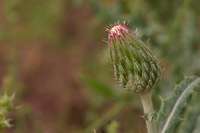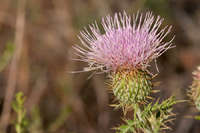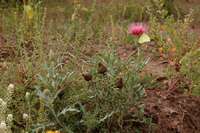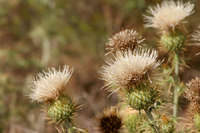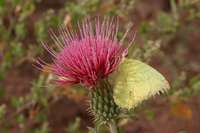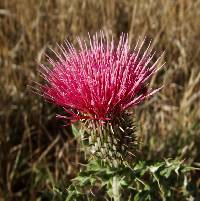|
|
|
|
Family: Asteraceae
yellowspine thistle
[Cnicus ochrocentrus (A. Gray) A. Gray] |
Perennials, 30-90 cm; crown sprouts or runner roots producing adventitious buds. Stems 1-20+, erect or ascending, densely gray-tomentose with non-septate trichomes; branches 0 or few, usually in distal 1/2, ascending. Leaves: blades oblong to narrowly elliptic, 10-30 × 2-8 cm, strongly undulate, margins coarsely dentate or shallowly to deeply pinnatifid with 8-15 pairs of lobes 0.5-2 cm, often revolute, lobes ± triangular, closely spaced, spreading, spinose-dentate and cleft into 2-5 spine-tipped divisions, main spines 5-20 mm, yellowish, abaxial faces densely white-tomentose, adaxial thinly gray-tomentose; basal usually present at flowering, winged-petiolate; principal cauline sessile, progressively reduced distally, bases ± auriculate to long-decurrent as spiny wings; distal cauline usually much reduced, less lobed. Heads 1-few, in leafy, ± corymbiform arrays. Peduncles 0-4 cm. Involucres ovoid to hemispheric or broadly campanulate, 2.5-4.5 × 2.5-4.5 cm in first-formed heads, often smaller in later ones, loosely arachnoid on phyllary margins or glabrate. Phyllaries in 5-10 series, imbricate, ovate (outer) to linear-lanceolate (inner), margins entire, abaxial faces with narrow glutinous ridge; outer and middle appressed, spines spreading, 3-12 mm; apices of inner often flexuous, expanded and flat, scabrid-margined, sometimes erose, spineless. Corollas white or pale lavender to purple, pink, or red, 25-45 mm, tubes 8-25 mm, throats 6-17 mm, lobes 6-15 mm; style tips 2-8 mm. Cypselae light brown, sometimes with lighter or darker streaks, 6-9 mm, apical collars colored like the body, narrow; pappi (white or tawny), 20-40 mm, usually noticeably shorter than corolla. 2n = 30, 31, 32, 34. FNA 2006, Martin and Hutchins 1980, Kearney and Peebles 1969, Kearny and Peebles 1979, Heil et al 2013 Duration: Perennial Nativity: Native Lifeform: Forb/Herb General: Perennial herbs, 30-90 cm tall; stems erect or ascending, simple or sparingly branched, densely gray-tomentose. Leaves: Basal leaves on winged petioles, usually still present at flowering; cauline leaves alternate, progressively reduced distally, the bases auriculate to long-decurrent with spiny wings; blades oblong to narrowly elliptic, 10-30 cm long by 2-8 cm wide, strongly undulate with coarsely dentate margins, or shallowly to deeply pinnatifid with 8-15 pairs of lobes; lobes triangular and tipped with strong spines, these 5-20 mm long, yellowish; lower surfaces of blades densely white-tomentose, upper surfaces thinly gray-tomentose. Flowers: Flower heads discoid, 1-3 per plant, located at branch tips; involucre (ring of bracts wrapped around the flower head) ovoid to hemispheric or broadly campanulate, 2-5 cm high, the bracts (phyllaries) imbricate in 5-10 series, glabrate or loosely arachnoid on margins, with a ridge of glands on the back and tipped with speading spines, these 3-12 mm long; florets all discs, the corollas cream-colored or rose-colored to deep carmine or purple, 25-45 mm long. Fruits: Achenes 6-9 mm long, light brown with lighter or darker streaks, topped with a pappus of white or tawny bristles, 2-4 cm long, noticeably shorter than the corolla. Ecology: Found in open areas, grasslands, and often in disturbed areas, from 4,500-8,000 ft (1372-2438 m); flowers June-October. Distribution: CA east to SD, south through AZ, NM and TX to n MEX. Notes: Distinguished from other Cirsium spp. by being shorter (< 1 m tall); densely tomentose; having appressed phyllaries with yellowish spreading spines about 1 cm long. Material from east-central and southeastern AZ and neighboring western NM is mostly var. martinii, with red, pink, or reddish-purple corollas and leaf bases that are clasping or short-decurrent, running along the stem for less than 1 cm. The more widespread var. ochrocentrum is also present in NM and AZ as well as the rest of the species- range, and has white, lavender, or purple corollas and long-decurrent leaf bases. Ethnobotany: Used as a wash for burns and sores; as a contraceptive; as a treatment for syphilis and diabetes; the roots were eaten; and blossoms were scattered at burial sites to keep wolves from digging up the body. Etymology: Cirsium is Greek for thistle, while ochrocentrum means having and ochre-colored center. Synonyms: Cnicus ochrocentrus, Carduus undulatus var. undulatus, Carduus ochrocentrus, Cnicus undulatus var. ochrocentrus Editor: SBuckley 2010, FSCoburn 2015, AHazelton 2015 |
|
|
|


